Essay: Leadership Styles and Patient Safety in Healthcare Settings
VerifiedAdded on 2022/12/29
|9
|2318
|61
Essay
AI Summary
This essay delves into the critical relationship between leadership styles and patient safety within healthcare environments. It begins by defining leadership and patient safety, establishing their interconnectedness, and emphasizing the importance of leadership in ensuring patient well-being. The essay then explores two prominent leadership styles: transformational and transactional leadership. Transformational leadership is presented as a style that fosters positive organizational developments by involving subordinates, creating awareness of rewards, and promoting long-range ambition and trust. The essay discusses how transformational leaders empower nurses and focus on cultural impacts to enhance patient safety. Conversely, transactional leadership is described as an exchange-based approach where leaders clarify objectives, reward achievements, and correct errors. The essay highlights how transactional leaders promote patient safety by engaging families, creating safe practices, and ensuring proper medication prescriptions. The conclusion reinforces the significance of patient safety in nursing care and underscores the role of various leadership styles in promoting excellent services and safe care within healthcare settings, referencing relevant literature.
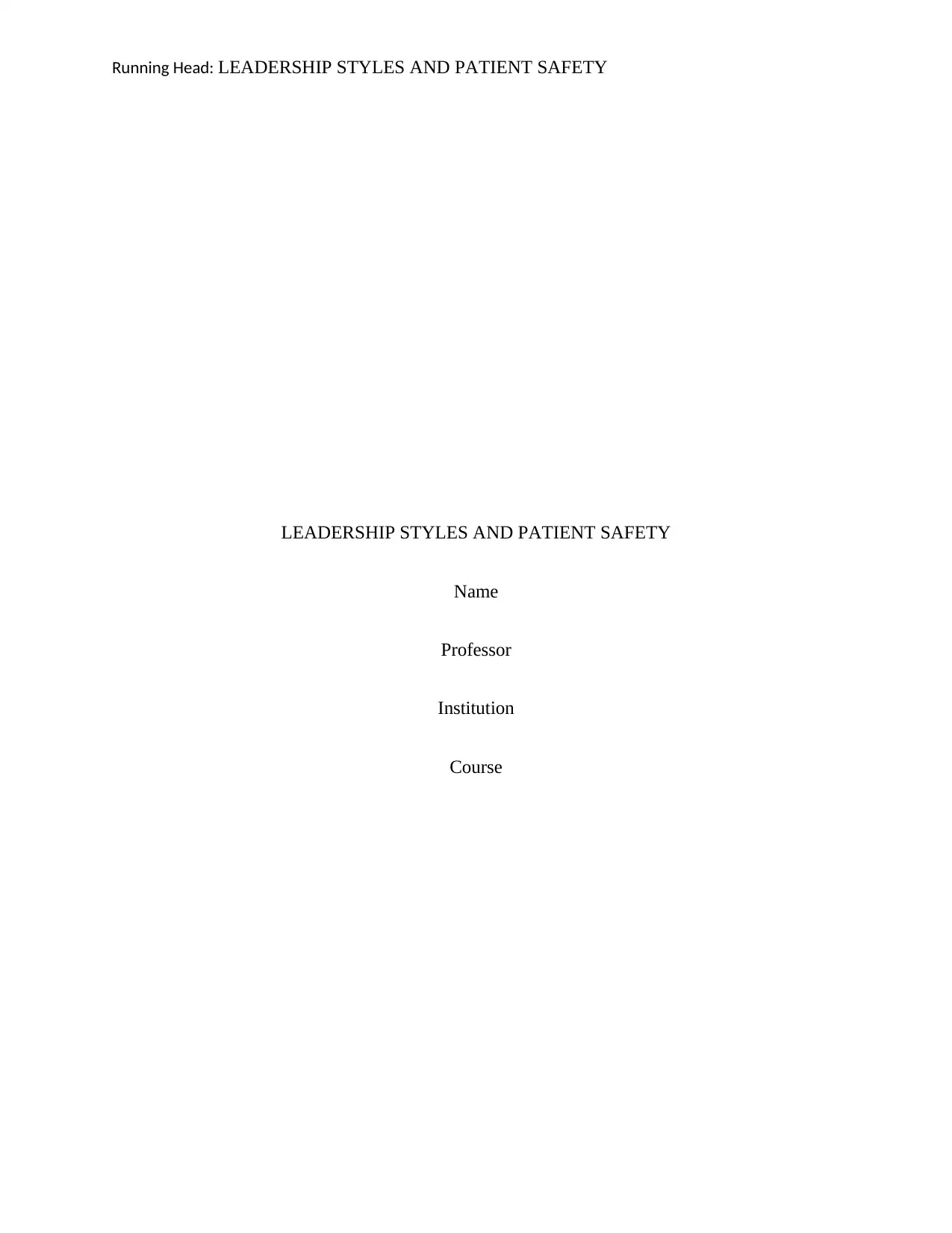
Running Head: LEADERSHIP STYLES AND PATIENT SAFETY
LEADERSHIP STYLES AND PATIENT SAFETY
Name
Professor
Institution
Course
LEADERSHIP STYLES AND PATIENT SAFETY
Name
Professor
Institution
Course
Paraphrase This Document
Need a fresh take? Get an instant paraphrase of this document with our AI Paraphraser
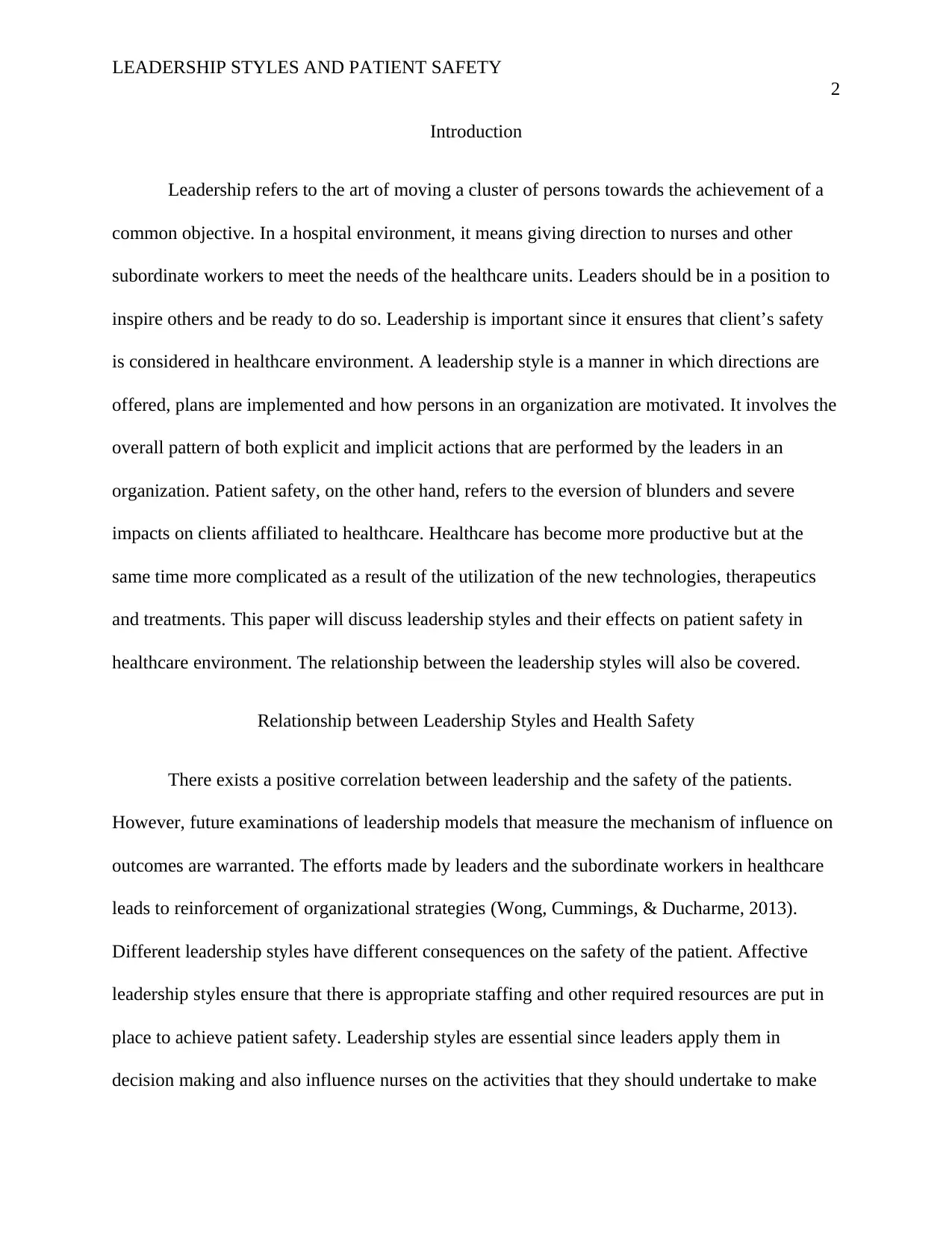
LEADERSHIP STYLES AND PATIENT SAFETY
2
Introduction
Leadership refers to the art of moving a cluster of persons towards the achievement of a
common objective. In a hospital environment, it means giving direction to nurses and other
subordinate workers to meet the needs of the healthcare units. Leaders should be in a position to
inspire others and be ready to do so. Leadership is important since it ensures that client’s safety
is considered in healthcare environment. A leadership style is a manner in which directions are
offered, plans are implemented and how persons in an organization are motivated. It involves the
overall pattern of both explicit and implicit actions that are performed by the leaders in an
organization. Patient safety, on the other hand, refers to the eversion of blunders and severe
impacts on clients affiliated to healthcare. Healthcare has become more productive but at the
same time more complicated as a result of the utilization of the new technologies, therapeutics
and treatments. This paper will discuss leadership styles and their effects on patient safety in
healthcare environment. The relationship between the leadership styles will also be covered.
Relationship between Leadership Styles and Health Safety
There exists a positive correlation between leadership and the safety of the patients.
However, future examinations of leadership models that measure the mechanism of influence on
outcomes are warranted. The efforts made by leaders and the subordinate workers in healthcare
leads to reinforcement of organizational strategies (Wong, Cummings, & Ducharme, 2013).
Different leadership styles have different consequences on the safety of the patient. Affective
leadership styles ensure that there is appropriate staffing and other required resources are put in
place to achieve patient safety. Leadership styles are essential since leaders apply them in
decision making and also influence nurses on the activities that they should undertake to make
2
Introduction
Leadership refers to the art of moving a cluster of persons towards the achievement of a
common objective. In a hospital environment, it means giving direction to nurses and other
subordinate workers to meet the needs of the healthcare units. Leaders should be in a position to
inspire others and be ready to do so. Leadership is important since it ensures that client’s safety
is considered in healthcare environment. A leadership style is a manner in which directions are
offered, plans are implemented and how persons in an organization are motivated. It involves the
overall pattern of both explicit and implicit actions that are performed by the leaders in an
organization. Patient safety, on the other hand, refers to the eversion of blunders and severe
impacts on clients affiliated to healthcare. Healthcare has become more productive but at the
same time more complicated as a result of the utilization of the new technologies, therapeutics
and treatments. This paper will discuss leadership styles and their effects on patient safety in
healthcare environment. The relationship between the leadership styles will also be covered.
Relationship between Leadership Styles and Health Safety
There exists a positive correlation between leadership and the safety of the patients.
However, future examinations of leadership models that measure the mechanism of influence on
outcomes are warranted. The efforts made by leaders and the subordinate workers in healthcare
leads to reinforcement of organizational strategies (Wong, Cummings, & Ducharme, 2013).
Different leadership styles have different consequences on the safety of the patient. Affective
leadership styles ensure that there is appropriate staffing and other required resources are put in
place to achieve patient safety. Leadership styles are essential since leaders apply them in
decision making and also influence nurses on the activities that they should undertake to make
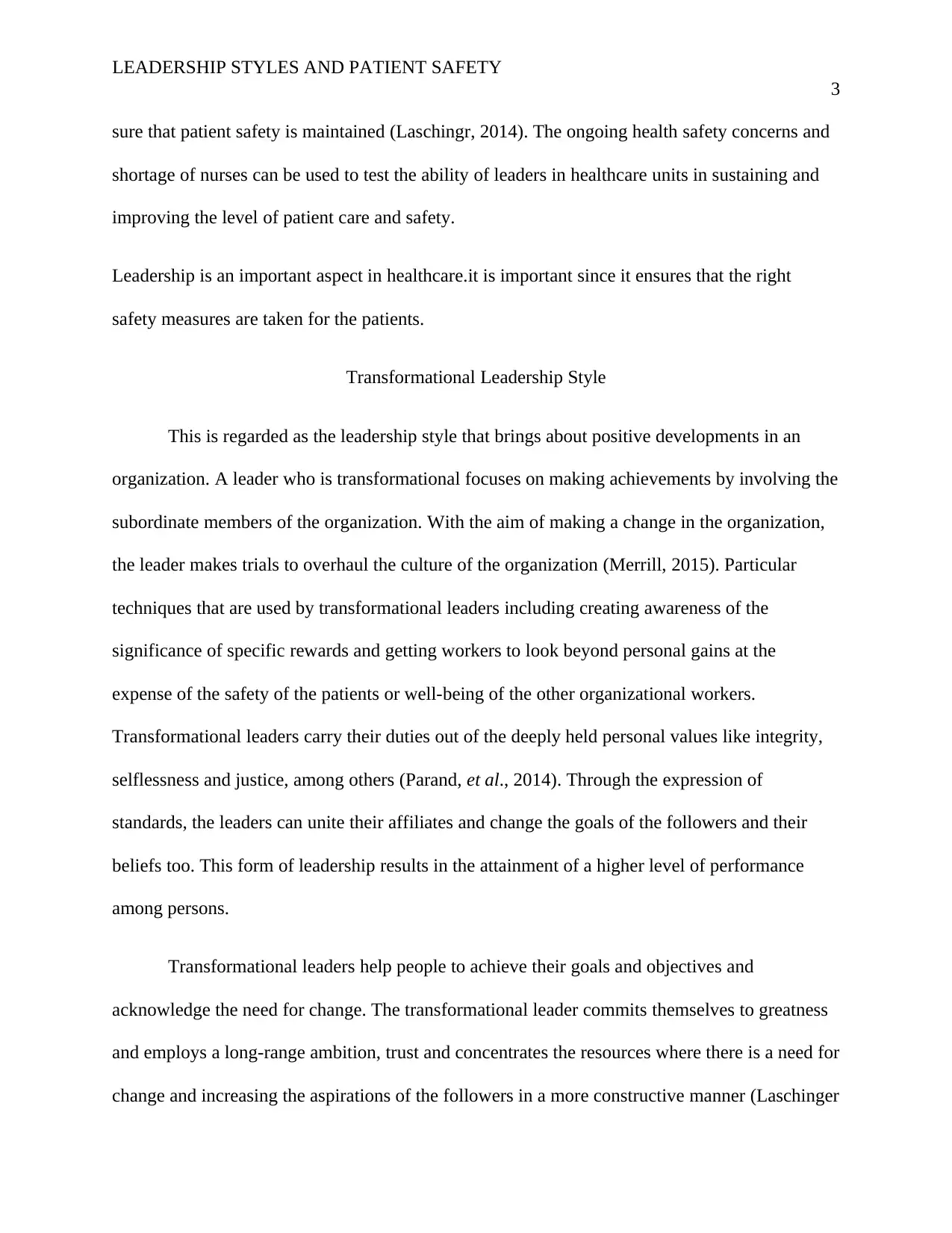
LEADERSHIP STYLES AND PATIENT SAFETY
3
sure that patient safety is maintained (Laschingr, 2014). The ongoing health safety concerns and
shortage of nurses can be used to test the ability of leaders in healthcare units in sustaining and
improving the level of patient care and safety.
Leadership is an important aspect in healthcare.it is important since it ensures that the right
safety measures are taken for the patients.
Transformational Leadership Style
This is regarded as the leadership style that brings about positive developments in an
organization. A leader who is transformational focuses on making achievements by involving the
subordinate members of the organization. With the aim of making a change in the organization,
the leader makes trials to overhaul the culture of the organization (Merrill, 2015). Particular
techniques that are used by transformational leaders including creating awareness of the
significance of specific rewards and getting workers to look beyond personal gains at the
expense of the safety of the patients or well-being of the other organizational workers.
Transformational leaders carry their duties out of the deeply held personal values like integrity,
selflessness and justice, among others (Parand, et al., 2014). Through the expression of
standards, the leaders can unite their affiliates and change the goals of the followers and their
beliefs too. This form of leadership results in the attainment of a higher level of performance
among persons.
Transformational leaders help people to achieve their goals and objectives and
acknowledge the need for change. The transformational leader commits themselves to greatness
and employs a long-range ambition, trust and concentrates the resources where there is a need for
change and increasing the aspirations of the followers in a more constructive manner (Laschinger
3
sure that patient safety is maintained (Laschingr, 2014). The ongoing health safety concerns and
shortage of nurses can be used to test the ability of leaders in healthcare units in sustaining and
improving the level of patient care and safety.
Leadership is an important aspect in healthcare.it is important since it ensures that the right
safety measures are taken for the patients.
Transformational Leadership Style
This is regarded as the leadership style that brings about positive developments in an
organization. A leader who is transformational focuses on making achievements by involving the
subordinate members of the organization. With the aim of making a change in the organization,
the leader makes trials to overhaul the culture of the organization (Merrill, 2015). Particular
techniques that are used by transformational leaders including creating awareness of the
significance of specific rewards and getting workers to look beyond personal gains at the
expense of the safety of the patients or well-being of the other organizational workers.
Transformational leaders carry their duties out of the deeply held personal values like integrity,
selflessness and justice, among others (Parand, et al., 2014). Through the expression of
standards, the leaders can unite their affiliates and change the goals of the followers and their
beliefs too. This form of leadership results in the attainment of a higher level of performance
among persons.
Transformational leaders help people to achieve their goals and objectives and
acknowledge the need for change. The transformational leader commits themselves to greatness
and employs a long-range ambition, trust and concentrates the resources where there is a need for
change and increasing the aspirations of the followers in a more constructive manner (Laschinger
⊘ This is a preview!⊘
Do you want full access?
Subscribe today to unlock all pages.

Trusted by 1+ million students worldwide
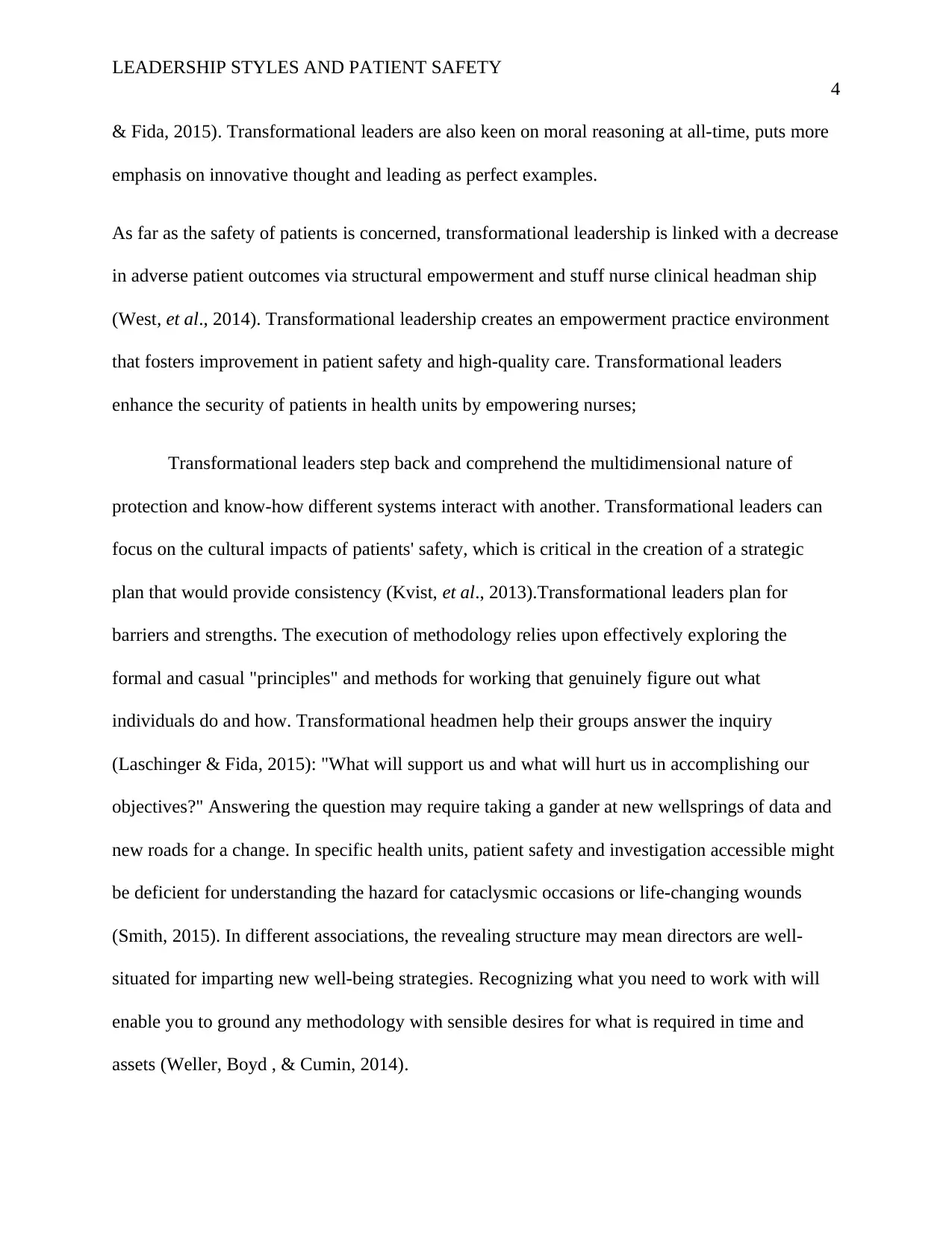
LEADERSHIP STYLES AND PATIENT SAFETY
4
& Fida, 2015). Transformational leaders are also keen on moral reasoning at all-time, puts more
emphasis on innovative thought and leading as perfect examples.
As far as the safety of patients is concerned, transformational leadership is linked with a decrease
in adverse patient outcomes via structural empowerment and stuff nurse clinical headman ship
(West, et al., 2014). Transformational leadership creates an empowerment practice environment
that fosters improvement in patient safety and high-quality care. Transformational leaders
enhance the security of patients in health units by empowering nurses;
Transformational leaders step back and comprehend the multidimensional nature of
protection and know-how different systems interact with another. Transformational leaders can
focus on the cultural impacts of patients' safety, which is critical in the creation of a strategic
plan that would provide consistency (Kvist, et al., 2013).Transformational leaders plan for
barriers and strengths. The execution of methodology relies upon effectively exploring the
formal and casual "principles" and methods for working that genuinely figure out what
individuals do and how. Transformational headmen help their groups answer the inquiry
(Laschinger & Fida, 2015): "What will support us and what will hurt us in accomplishing our
objectives?" Answering the question may require taking a gander at new wellsprings of data and
new roads for a change. In specific health units, patient safety and investigation accessible might
be deficient for understanding the hazard for cataclysmic occasions or life-changing wounds
(Smith, 2015). In different associations, the revealing structure may mean directors are well-
situated for imparting new well-being strategies. Recognizing what you need to work with will
enable you to ground any methodology with sensible desires for what is required in time and
assets (Weller, Boyd , & Cumin, 2014).
4
& Fida, 2015). Transformational leaders are also keen on moral reasoning at all-time, puts more
emphasis on innovative thought and leading as perfect examples.
As far as the safety of patients is concerned, transformational leadership is linked with a decrease
in adverse patient outcomes via structural empowerment and stuff nurse clinical headman ship
(West, et al., 2014). Transformational leadership creates an empowerment practice environment
that fosters improvement in patient safety and high-quality care. Transformational leaders
enhance the security of patients in health units by empowering nurses;
Transformational leaders step back and comprehend the multidimensional nature of
protection and know-how different systems interact with another. Transformational leaders can
focus on the cultural impacts of patients' safety, which is critical in the creation of a strategic
plan that would provide consistency (Kvist, et al., 2013).Transformational leaders plan for
barriers and strengths. The execution of methodology relies upon effectively exploring the
formal and casual "principles" and methods for working that genuinely figure out what
individuals do and how. Transformational headmen help their groups answer the inquiry
(Laschinger & Fida, 2015): "What will support us and what will hurt us in accomplishing our
objectives?" Answering the question may require taking a gander at new wellsprings of data and
new roads for a change. In specific health units, patient safety and investigation accessible might
be deficient for understanding the hazard for cataclysmic occasions or life-changing wounds
(Smith, 2015). In different associations, the revealing structure may mean directors are well-
situated for imparting new well-being strategies. Recognizing what you need to work with will
enable you to ground any methodology with sensible desires for what is required in time and
assets (Weller, Boyd , & Cumin, 2014).
Paraphrase This Document
Need a fresh take? Get an instant paraphrase of this document with our AI Paraphraser
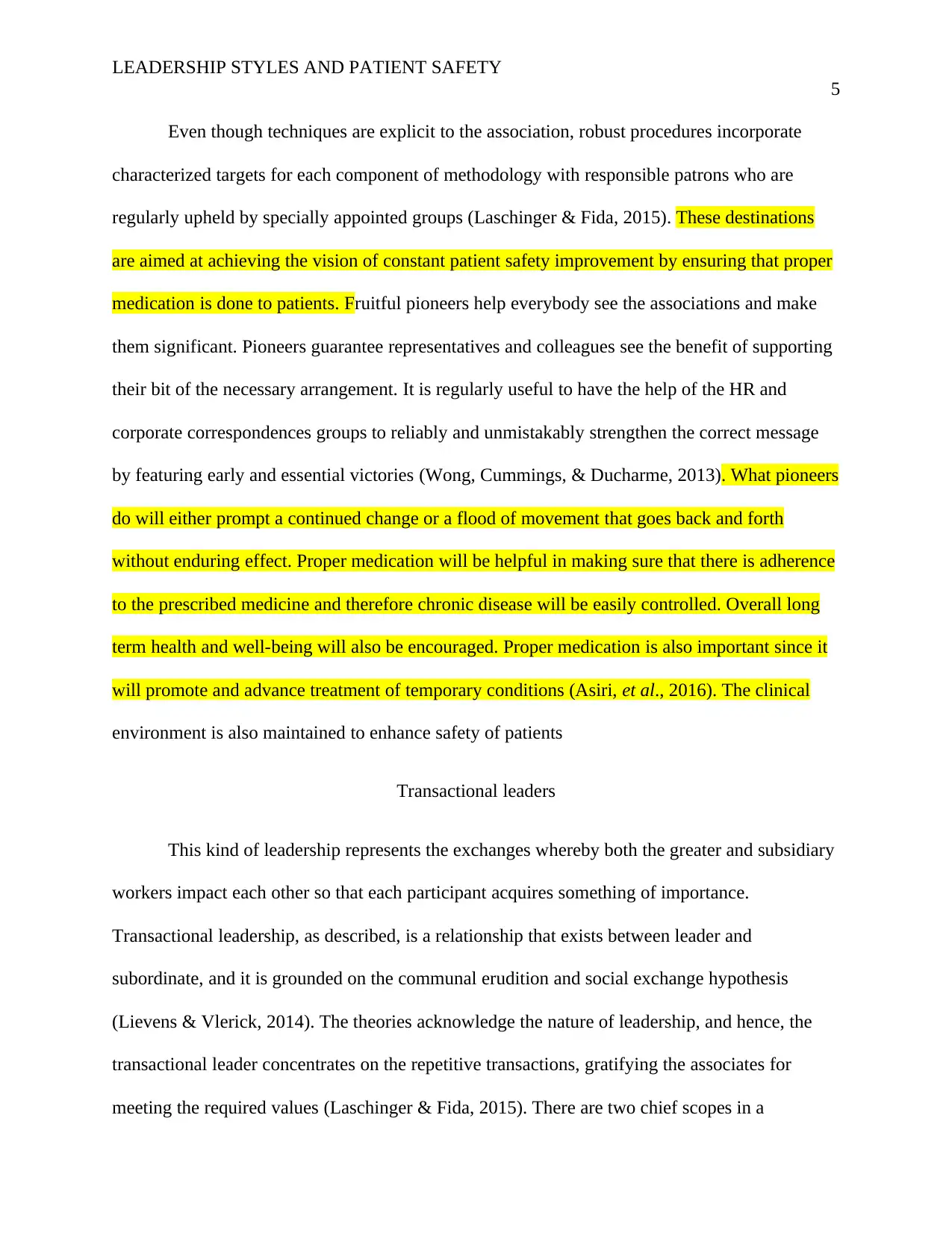
LEADERSHIP STYLES AND PATIENT SAFETY
5
Even though techniques are explicit to the association, robust procedures incorporate
characterized targets for each component of methodology with responsible patrons who are
regularly upheld by specially appointed groups (Laschinger & Fida, 2015). These destinations
are aimed at achieving the vision of constant patient safety improvement by ensuring that proper
medication is done to patients. Fruitful pioneers help everybody see the associations and make
them significant. Pioneers guarantee representatives and colleagues see the benefit of supporting
their bit of the necessary arrangement. It is regularly useful to have the help of the HR and
corporate correspondences groups to reliably and unmistakably strengthen the correct message
by featuring early and essential victories (Wong, Cummings, & Ducharme, 2013). What pioneers
do will either prompt a continued change or a flood of movement that goes back and forth
without enduring effect. Proper medication will be helpful in making sure that there is adherence
to the prescribed medicine and therefore chronic disease will be easily controlled. Overall long
term health and well-being will also be encouraged. Proper medication is also important since it
will promote and advance treatment of temporary conditions (Asiri, et al., 2016). The clinical
environment is also maintained to enhance safety of patients
Transactional leaders
This kind of leadership represents the exchanges whereby both the greater and subsidiary
workers impact each other so that each participant acquires something of importance.
Transactional leadership, as described, is a relationship that exists between leader and
subordinate, and it is grounded on the communal erudition and social exchange hypothesis
(Lievens & Vlerick, 2014). The theories acknowledge the nature of leadership, and hence, the
transactional leader concentrates on the repetitive transactions, gratifying the associates for
meeting the required values (Laschinger & Fida, 2015). There are two chief scopes in a
5
Even though techniques are explicit to the association, robust procedures incorporate
characterized targets for each component of methodology with responsible patrons who are
regularly upheld by specially appointed groups (Laschinger & Fida, 2015). These destinations
are aimed at achieving the vision of constant patient safety improvement by ensuring that proper
medication is done to patients. Fruitful pioneers help everybody see the associations and make
them significant. Pioneers guarantee representatives and colleagues see the benefit of supporting
their bit of the necessary arrangement. It is regularly useful to have the help of the HR and
corporate correspondences groups to reliably and unmistakably strengthen the correct message
by featuring early and essential victories (Wong, Cummings, & Ducharme, 2013). What pioneers
do will either prompt a continued change or a flood of movement that goes back and forth
without enduring effect. Proper medication will be helpful in making sure that there is adherence
to the prescribed medicine and therefore chronic disease will be easily controlled. Overall long
term health and well-being will also be encouraged. Proper medication is also important since it
will promote and advance treatment of temporary conditions (Asiri, et al., 2016). The clinical
environment is also maintained to enhance safety of patients
Transactional leaders
This kind of leadership represents the exchanges whereby both the greater and subsidiary
workers impact each other so that each participant acquires something of importance.
Transactional leadership, as described, is a relationship that exists between leader and
subordinate, and it is grounded on the communal erudition and social exchange hypothesis
(Lievens & Vlerick, 2014). The theories acknowledge the nature of leadership, and hence, the
transactional leader concentrates on the repetitive transactions, gratifying the associates for
meeting the required values (Laschinger & Fida, 2015). There are two chief scopes in a
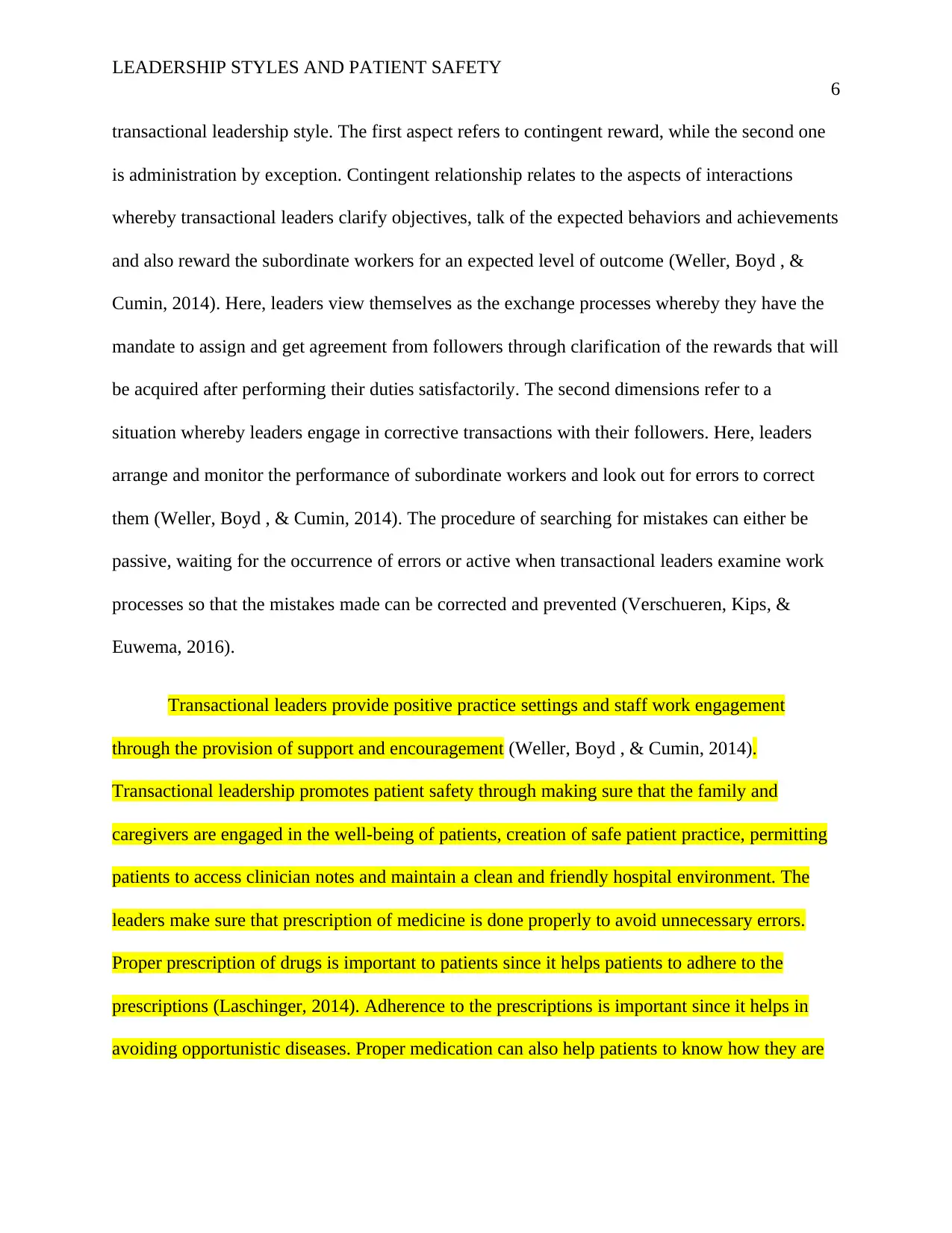
LEADERSHIP STYLES AND PATIENT SAFETY
6
transactional leadership style. The first aspect refers to contingent reward, while the second one
is administration by exception. Contingent relationship relates to the aspects of interactions
whereby transactional leaders clarify objectives, talk of the expected behaviors and achievements
and also reward the subordinate workers for an expected level of outcome (Weller, Boyd , &
Cumin, 2014). Here, leaders view themselves as the exchange processes whereby they have the
mandate to assign and get agreement from followers through clarification of the rewards that will
be acquired after performing their duties satisfactorily. The second dimensions refer to a
situation whereby leaders engage in corrective transactions with their followers. Here, leaders
arrange and monitor the performance of subordinate workers and look out for errors to correct
them (Weller, Boyd , & Cumin, 2014). The procedure of searching for mistakes can either be
passive, waiting for the occurrence of errors or active when transactional leaders examine work
processes so that the mistakes made can be corrected and prevented (Verschueren, Kips, &
Euwema, 2016).
Transactional leaders provide positive practice settings and staff work engagement
through the provision of support and encouragement (Weller, Boyd , & Cumin, 2014).
Transactional leadership promotes patient safety through making sure that the family and
caregivers are engaged in the well-being of patients, creation of safe patient practice, permitting
patients to access clinician notes and maintain a clean and friendly hospital environment. The
leaders make sure that prescription of medicine is done properly to avoid unnecessary errors.
Proper prescription of drugs is important to patients since it helps patients to adhere to the
prescriptions (Laschinger, 2014). Adherence to the prescriptions is important since it helps in
avoiding opportunistic diseases. Proper medication can also help patients to know how they are
6
transactional leadership style. The first aspect refers to contingent reward, while the second one
is administration by exception. Contingent relationship relates to the aspects of interactions
whereby transactional leaders clarify objectives, talk of the expected behaviors and achievements
and also reward the subordinate workers for an expected level of outcome (Weller, Boyd , &
Cumin, 2014). Here, leaders view themselves as the exchange processes whereby they have the
mandate to assign and get agreement from followers through clarification of the rewards that will
be acquired after performing their duties satisfactorily. The second dimensions refer to a
situation whereby leaders engage in corrective transactions with their followers. Here, leaders
arrange and monitor the performance of subordinate workers and look out for errors to correct
them (Weller, Boyd , & Cumin, 2014). The procedure of searching for mistakes can either be
passive, waiting for the occurrence of errors or active when transactional leaders examine work
processes so that the mistakes made can be corrected and prevented (Verschueren, Kips, &
Euwema, 2016).
Transactional leaders provide positive practice settings and staff work engagement
through the provision of support and encouragement (Weller, Boyd , & Cumin, 2014).
Transactional leadership promotes patient safety through making sure that the family and
caregivers are engaged in the well-being of patients, creation of safe patient practice, permitting
patients to access clinician notes and maintain a clean and friendly hospital environment. The
leaders make sure that prescription of medicine is done properly to avoid unnecessary errors.
Proper prescription of drugs is important to patients since it helps patients to adhere to the
prescriptions (Laschinger, 2014). Adherence to the prescriptions is important since it helps in
avoiding opportunistic diseases. Proper medication can also help patients to know how they are
⊘ This is a preview!⊘
Do you want full access?
Subscribe today to unlock all pages.

Trusted by 1+ million students worldwide
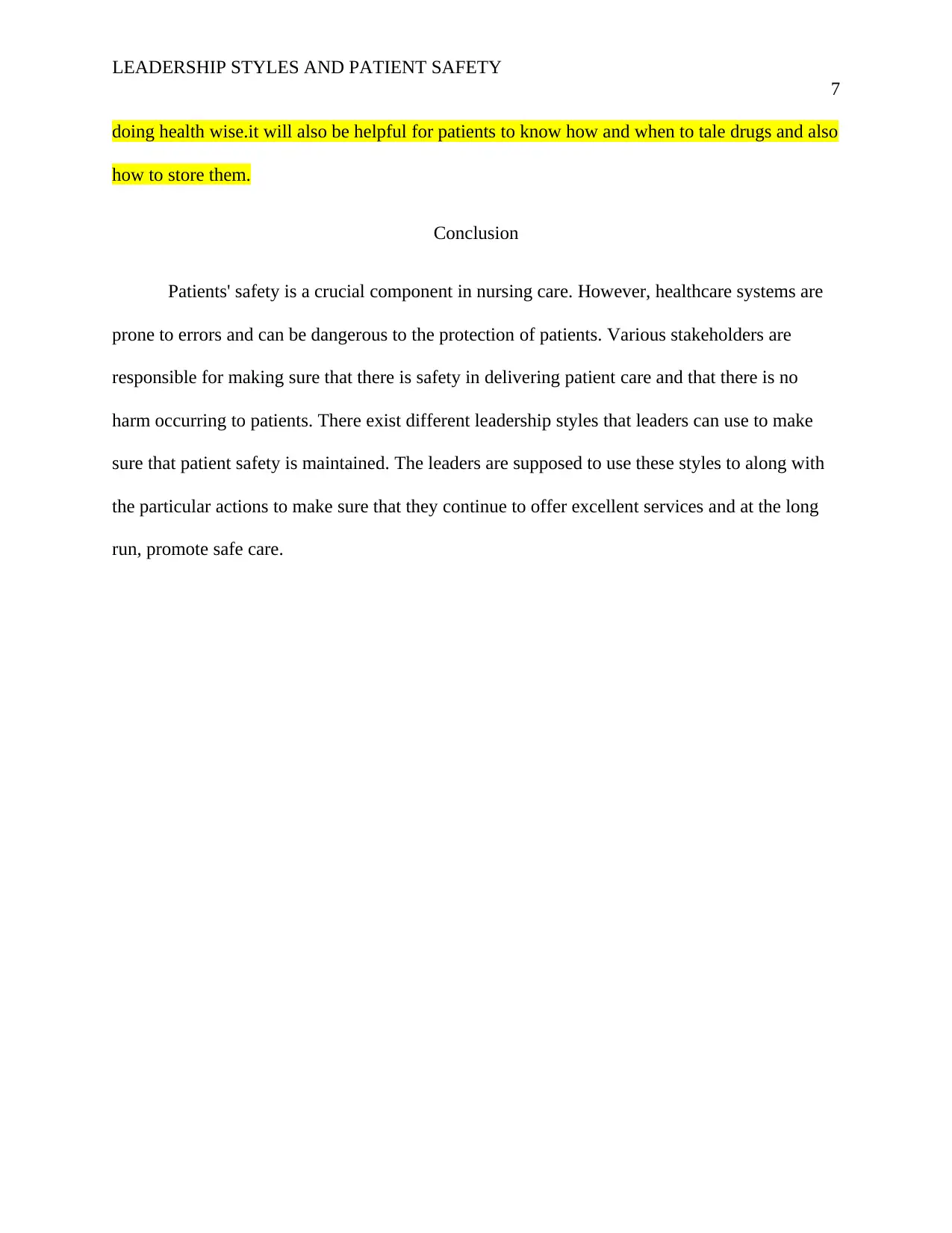
LEADERSHIP STYLES AND PATIENT SAFETY
7
doing health wise.it will also be helpful for patients to know how and when to tale drugs and also
how to store them.
Conclusion
Patients' safety is a crucial component in nursing care. However, healthcare systems are
prone to errors and can be dangerous to the protection of patients. Various stakeholders are
responsible for making sure that there is safety in delivering patient care and that there is no
harm occurring to patients. There exist different leadership styles that leaders can use to make
sure that patient safety is maintained. The leaders are supposed to use these styles to along with
the particular actions to make sure that they continue to offer excellent services and at the long
run, promote safe care.
7
doing health wise.it will also be helpful for patients to know how and when to tale drugs and also
how to store them.
Conclusion
Patients' safety is a crucial component in nursing care. However, healthcare systems are
prone to errors and can be dangerous to the protection of patients. Various stakeholders are
responsible for making sure that there is safety in delivering patient care and that there is no
harm occurring to patients. There exist different leadership styles that leaders can use to make
sure that patient safety is maintained. The leaders are supposed to use these styles to along with
the particular actions to make sure that they continue to offer excellent services and at the long
run, promote safe care.
Paraphrase This Document
Need a fresh take? Get an instant paraphrase of this document with our AI Paraphraser
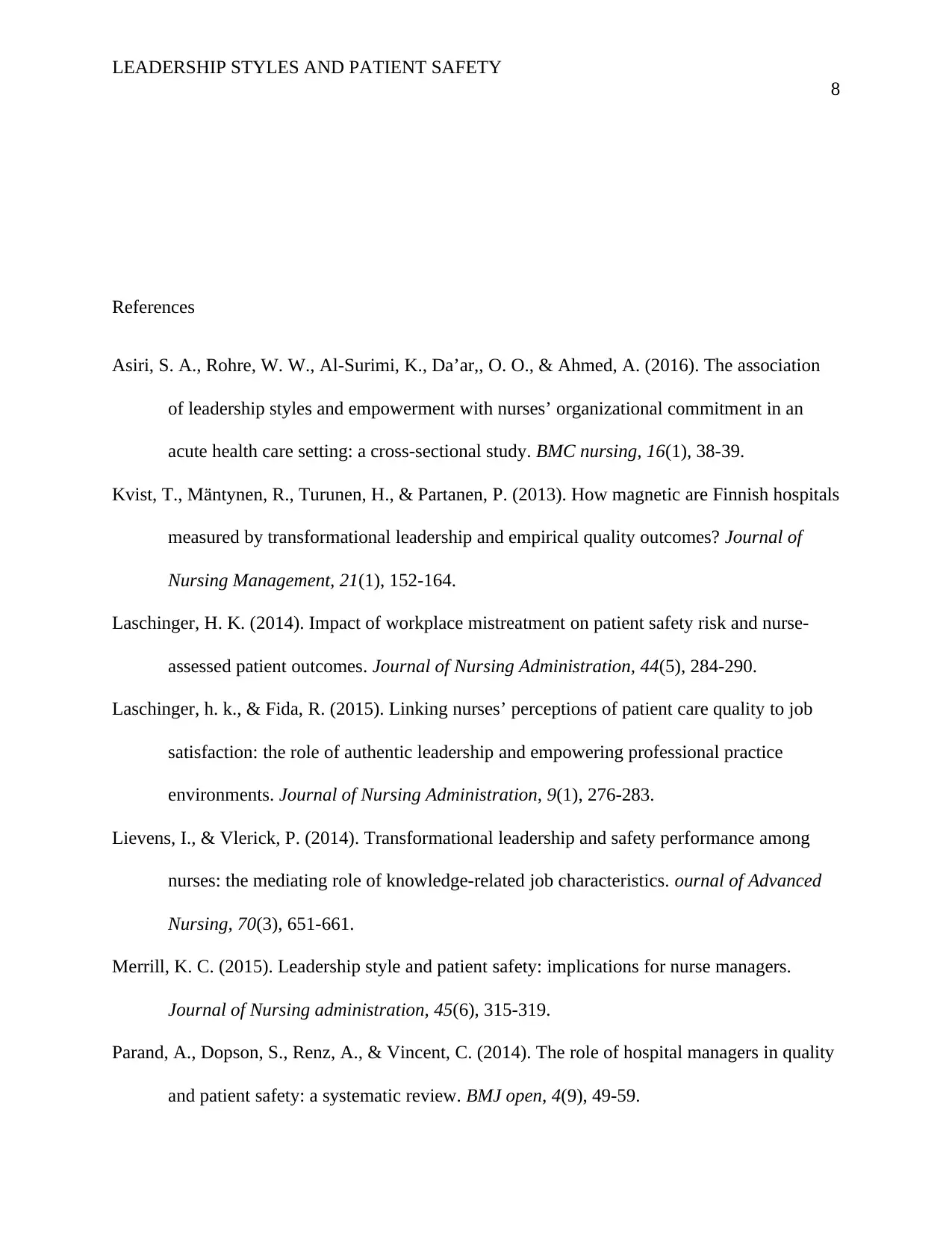
LEADERSHIP STYLES AND PATIENT SAFETY
8
References
Asiri, S. A., Rohre, W. W., Al-Surimi, K., Da’ar,, O. O., & Ahmed, A. (2016). The association
of leadership styles and empowerment with nurses’ organizational commitment in an
acute health care setting: a cross-sectional study. BMC nursing, 16(1), 38-39.
Kvist, T., Mäntynen, R., Turunen, H., & Partanen, P. (2013). How magnetic are Finnish hospitals
measured by transformational leadership and empirical quality outcomes? Journal of
Nursing Management, 21(1), 152-164.
Laschinger, H. K. (2014). Impact of workplace mistreatment on patient safety risk and nurse-
assessed patient outcomes. Journal of Nursing Administration, 44(5), 284-290.
Laschinger, h. k., & Fida, R. (2015). Linking nurses’ perceptions of patient care quality to job
satisfaction: the role of authentic leadership and empowering professional practice
environments. Journal of Nursing Administration, 9(1), 276-283.
Lievens, I., & Vlerick, P. (2014). Transformational leadership and safety performance among
nurses: the mediating role of knowledge‐related job characteristics. ournal of Advanced
Nursing, 70(3), 651-661.
Merrill, K. C. (2015). Leadership style and patient safety: implications for nurse managers.
Journal of Nursing administration, 45(6), 315-319.
Parand, A., Dopson, S., Renz, A., & Vincent, C. (2014). The role of hospital managers in quality
and patient safety: a systematic review. BMJ open, 4(9), 49-59.
8
References
Asiri, S. A., Rohre, W. W., Al-Surimi, K., Da’ar,, O. O., & Ahmed, A. (2016). The association
of leadership styles and empowerment with nurses’ organizational commitment in an
acute health care setting: a cross-sectional study. BMC nursing, 16(1), 38-39.
Kvist, T., Mäntynen, R., Turunen, H., & Partanen, P. (2013). How magnetic are Finnish hospitals
measured by transformational leadership and empirical quality outcomes? Journal of
Nursing Management, 21(1), 152-164.
Laschinger, H. K. (2014). Impact of workplace mistreatment on patient safety risk and nurse-
assessed patient outcomes. Journal of Nursing Administration, 44(5), 284-290.
Laschinger, h. k., & Fida, R. (2015). Linking nurses’ perceptions of patient care quality to job
satisfaction: the role of authentic leadership and empowering professional practice
environments. Journal of Nursing Administration, 9(1), 276-283.
Lievens, I., & Vlerick, P. (2014). Transformational leadership and safety performance among
nurses: the mediating role of knowledge‐related job characteristics. ournal of Advanced
Nursing, 70(3), 651-661.
Merrill, K. C. (2015). Leadership style and patient safety: implications for nurse managers.
Journal of Nursing administration, 45(6), 315-319.
Parand, A., Dopson, S., Renz, A., & Vincent, C. (2014). The role of hospital managers in quality
and patient safety: a systematic review. BMJ open, 4(9), 49-59.
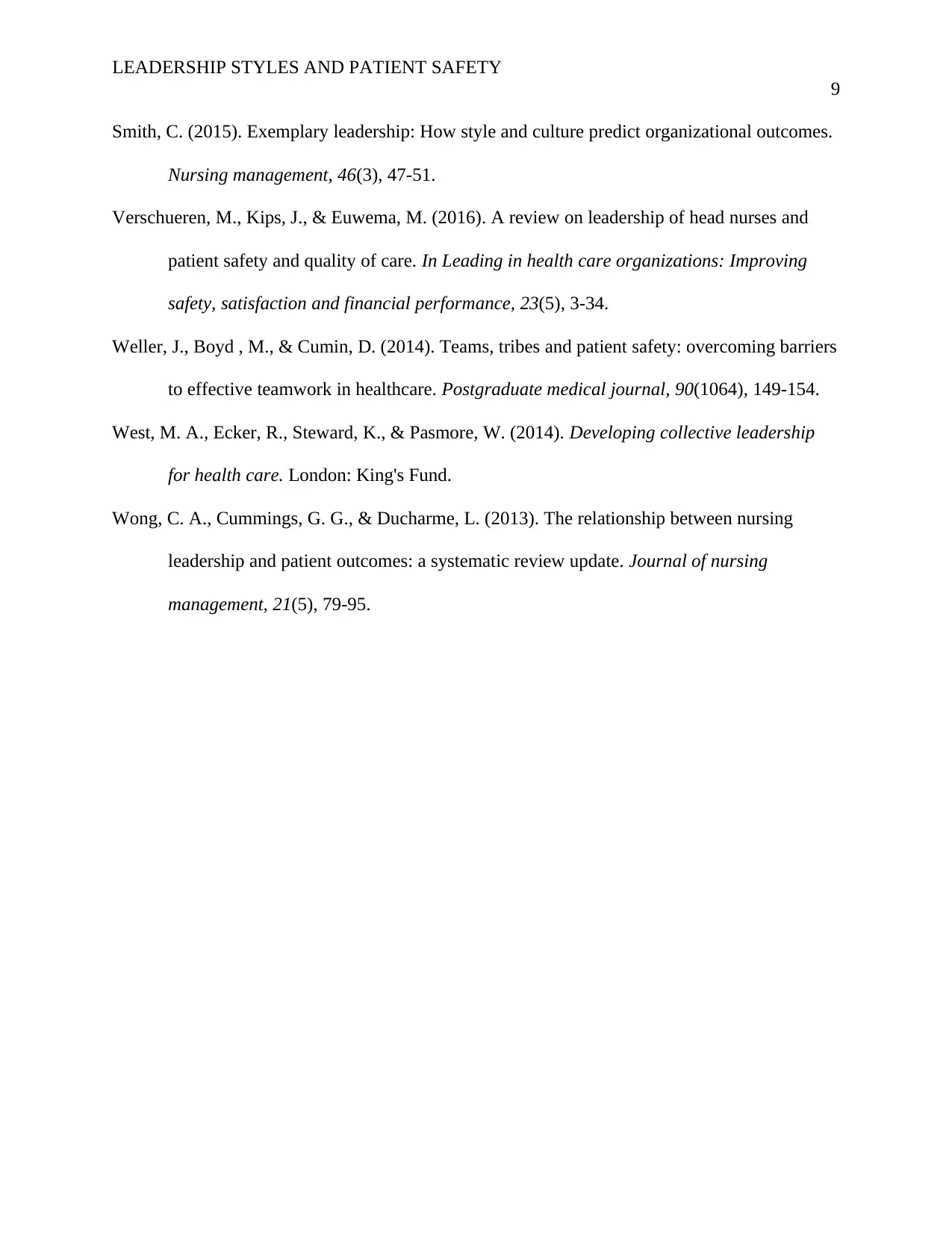
LEADERSHIP STYLES AND PATIENT SAFETY
9
Smith, C. (2015). Exemplary leadership: How style and culture predict organizational outcomes.
Nursing management, 46(3), 47-51.
Verschueren, M., Kips, J., & Euwema, M. (2016). A review on leadership of head nurses and
patient safety and quality of care. In Leading in health care organizations: Improving
safety, satisfaction and financial performance, 23(5), 3-34.
Weller, J., Boyd , M., & Cumin, D. (2014). Teams, tribes and patient safety: overcoming barriers
to effective teamwork in healthcare. Postgraduate medical journal, 90(1064), 149-154.
West, M. A., Ecker, R., Steward, K., & Pasmore, W. (2014). Developing collective leadership
for health care. London: King's Fund.
Wong, C. A., Cummings, G. G., & Ducharme, L. (2013). The relationship between nursing
leadership and patient outcomes: a systematic review update. Journal of nursing
management, 21(5), 79-95.
9
Smith, C. (2015). Exemplary leadership: How style and culture predict organizational outcomes.
Nursing management, 46(3), 47-51.
Verschueren, M., Kips, J., & Euwema, M. (2016). A review on leadership of head nurses and
patient safety and quality of care. In Leading in health care organizations: Improving
safety, satisfaction and financial performance, 23(5), 3-34.
Weller, J., Boyd , M., & Cumin, D. (2014). Teams, tribes and patient safety: overcoming barriers
to effective teamwork in healthcare. Postgraduate medical journal, 90(1064), 149-154.
West, M. A., Ecker, R., Steward, K., & Pasmore, W. (2014). Developing collective leadership
for health care. London: King's Fund.
Wong, C. A., Cummings, G. G., & Ducharme, L. (2013). The relationship between nursing
leadership and patient outcomes: a systematic review update. Journal of nursing
management, 21(5), 79-95.
⊘ This is a preview!⊘
Do you want full access?
Subscribe today to unlock all pages.

Trusted by 1+ million students worldwide
1 out of 9
Related Documents
Your All-in-One AI-Powered Toolkit for Academic Success.
+13062052269
info@desklib.com
Available 24*7 on WhatsApp / Email
![[object Object]](/_next/static/media/star-bottom.7253800d.svg)
Unlock your academic potential
Copyright © 2020–2025 A2Z Services. All Rights Reserved. Developed and managed by ZUCOL.





